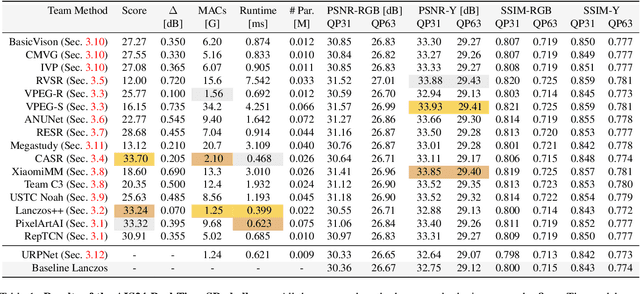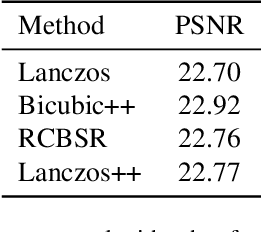Zhijun Lei
AIM 2024 Challenge on Efficient Video Super-Resolution for AV1 Compressed Content
Sep 25, 2024



Abstract:Video super-resolution (VSR) is a critical task for enhancing low-bitrate and low-resolution videos, particularly in streaming applications. While numerous solutions have been developed, they often suffer from high computational demands, resulting in low frame rates (FPS) and poor power efficiency, especially on mobile platforms. In this work, we compile different methods to address these challenges, the solutions are end-to-end real-time video super-resolution frameworks optimized for both high performance and low runtime. We also introduce a new test set of high-quality 4K videos to further validate the approaches. The proposed solutions tackle video up-scaling for two applications: 540p to 4K (x4) as a general case, and 360p to 1080p (x3) more tailored towards mobile devices. In both tracks, the solutions have a reduced number of parameters and operations (MACs), allow high FPS, and improve VMAF and PSNR over interpolation baselines. This report gauges some of the most efficient video super-resolution methods to date.
SVT-AV1 Encoding Bitrate Estimation Using Motion Search Information
Jul 08, 2024



Abstract:Enabling high compression efficiency while keeping encoding energy consumption at a low level, requires prioritization of which videos need more sophisticated encoding techniques. However, the effects vary highly based on the content, and information on how good a video can be compressed is required. This can be measured by estimating the encoded bitstream size prior to encoding. We identified the errors between estimated motion vectors from Motion Search, an algorithm that predicts temporal changes in videos, correlates well to the encoded bitstream size. Combining Motion Search with Random Forests, the encoding bitrate can be estimated with a Pearson correlation of above 0.96.
Real-Time 4K Super-Resolution of Compressed AVIF Images. AIS 2024 Challenge Survey
Apr 25, 2024



Abstract:This paper introduces a novel benchmark as part of the AIS 2024 Real-Time Image Super-Resolution (RTSR) Challenge, which aims to upscale compressed images from 540p to 4K resolution (4x factor) in real-time on commercial GPUs. For this, we use a diverse test set containing a variety of 4K images ranging from digital art to gaming and photography. The images are compressed using the modern AVIF codec, instead of JPEG. All the proposed methods improve PSNR fidelity over Lanczos interpolation, and process images under 10ms. Out of the 160 participants, 25 teams submitted their code and models. The solutions present novel designs tailored for memory-efficiency and runtime on edge devices. This survey describes the best solutions for real-time SR of compressed high-resolution images.
Encoding Time and Energy Model for SVT-AV1 based on Video Complexity
Jan 30, 2024Abstract:The share of online video traffic in global carbon dioxide emissions is growing steadily. To comply with the demand for video media, dedicated compression techniques are continuously optimized, but at the expense of increasingly higher computational demands and thus rising energy consumption at the video encoder side. In order to find the best trade-off between compression and energy consumption, modeling encoding energy for a wide range of encoding parameters is crucial. We propose an encoding time and energy model for SVT-AV1 based on empirical relations between the encoding time and video parameters as well as encoder configurations. Furthermore, we model the influence of video content by established content descriptors such as spatial and temporal information. We then use the predicted encoding time to estimate the required energy demand and achieve a prediction error of 19.6 % for encoding time and 20.9 % for encoding energy.
Encoder Complexity Control in SVT-AV1 by Speed-Adaptive Preset Switching
Jul 11, 2023


Abstract:Current developments in video encoding technology lead to continuously improving compression performance but at the expense of increasingly higher computational demands. Regarding the online video traffic increases during the last years and the concomitant need for video encoding, encoder complexity control mechanisms are required to restrict the processing time to a sufficient extent in order to find a reasonable trade-off between performance and complexity. We present a complexity control mechanism in SVT-AV1 by using speed-adaptive preset switching to comply with the remaining time budget. This method enables encoding with a user-defined time constraint within the complete preset range with an average precision of 8.9 \% without introducing any additional latencies.
 Add to Chrome
Add to Chrome Add to Firefox
Add to Firefox Add to Edge
Add to Edge